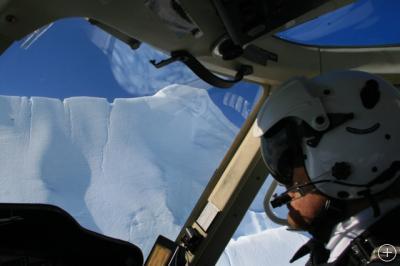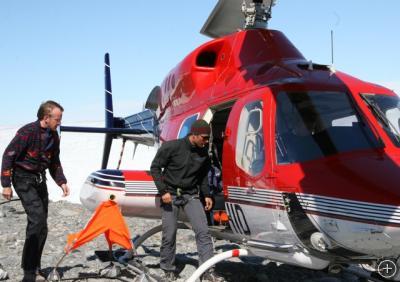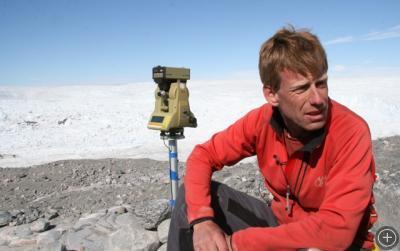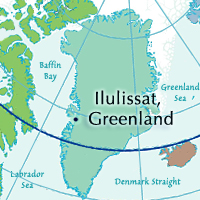Facing the Glacier
ILULISSAT, GREENLAND– Lisa and I had just flown into the tiny Ilulissat airport and were told we were catching a helicopter ride that afternoon to the Jakobshavn Isbrae, one of the fastest-moving and most productive glaciers in the world.
We had arranged a helo ride out to Mark Fahnestock’s research camp and had been hoping to stay out there for a few days in tents, but it turned out we couldn’t get a return flight so we had to scrap the camping adventure. That also meant that this two-hour visit would be our only chance to see Jakobshavn from a vantage point right next to its calving front where the glacier drops huge icebergs into the sea.

Our helicopter pilot, Morten Haeurbach from Denmark, flew us through some beautiful icebergs on our way back from the Jakobshavn Glacier.
The helicopter ride was thrilling, not least because a strong wind buffeted our landing and Morten, our helicopter pilot, had to make two approaches. We jumped out, said ‘Hi’ to Mark, and then got out of his way. To scientists, helicopter work can be a stressful necessity as fuel and flight time are limited for them to accomplish their tasks. If they don’t finish before the helo has to leave, a year’s worth of data collection could be jeopardized. So Lisa and I left Mark and his colleague to their work, which gave us a chance to walk around the bluff overlooking the 450-foot face of this magnificent glacier. I had heard that huge icebergs a cubic kilometer in size can calve off this very spot and was really hoping it would happen while we were there with our cameras… but that was pushing it since events of that size happen at the rate of just one a week.
Mark Fahnestock, a glaciologist from the University of New Hampshire, has been studying the Jakobshavn glacier for over five years and has been there in person for many huge calving events (he promised to share footage with us if we don’t catch one ourselves). In the early 2000s, the glacier started speeding up and it’s currently moving twice as fast as previous measurements. Scientists aren’t exactly sure why, but they’ve implicated a few suspects. I know what you’re thinking: global warming. But simple warming doesn’t explain the mechanics of glacier flow or the observations that scientists have made the past few years including surface melt breaking through and lubricating the base of the glacier (the work of Sarah Das and Ian Joughin), warming ocean temperatures undercutting the ice, and the loss of the ice tongue in summer that had been serving as a kind of dam holding back the Jakobshavn.
To get a better handle on how global warming might be impacting the dynamics of glacier flow, Mark has been outfitting the Jakobshavn with instruments including GPS and surveying tools and pointing multiple cameras at its face to document calving events. He’s interested in whether these large events are a local phenomena along the calving front or whether they involve larger portions of the Greenland Ice Sheet. Like other glaciologists, he is also interested in the contribution of glaciers like the Jakobshavn in shedding ice from large ice sheets in Greenland and Antarctica and whether this loss is being accelerated.
On the day we visited his camp, Mark and his colleagues were placing 10 tripod-mounted reflectors on the ice that will be used to track the relative speed of the glacier using a sophisticated Swiss surveying instrument called a theodolite. We watched as they picked up three reflectors at a time and flew over the ice sheet to place each of them behind the glacier front.
After all ten had been scattered in their designated spots on the ice, we made a quick stop in the helo to check in with Mark’s Swiss colleague Martin Lüthi. Martin was programming the Leica theodolite to keep track of the reflectors’ changing positions and calculate the speed of Jakobshavn glacier.
The day’s missions appeared to be accomplished, so Mark could relax and chat a bit before the helicopter took Lisa and I back to Ilulissat. We hope to catch up with him after he comes out of the field and find out what he’s learned this season about how the glacier is changing.
By the way, we didn’t see a calving event so we’ll have to rely on Mark’s video which we hope to post soon with his interview.














Marvelous reading! I am wondering if you encountered any biologists studying birds while you were there? I am working on a summer/fall summary of interesting bird reports for 2008 in Greenland and desperately seeking more good contacts! Many thanks, Ned Brinkley, editor, North American Birds journal